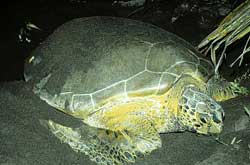 Sea turtles that receive the highest protection in Costa Rica and other neighboring countries are dying by the thousands at the hands of unregulated - and unsustainable - commercial fishing in Nicaragua, according to a study by the Bronx Zoo based Wildlife Conservation Society.
Sea turtles that receive the highest protection in Costa Rica and other neighboring countries are dying by the thousands at the hands of unregulated - and unsustainable - commercial fishing in Nicaragua, according to a study by the Bronx Zoo based Wildlife Conservation Society.
The study, appearing in the latest issue of the journal Herpetologica, found that turtles tagged in Nicaragua have only little more than a 50 percent chance of surviving until the next year. This includes adult turtles from Tortuguero, a world famous turtle-nesting beach in Costa Rica. For a slow-growing, slow-to-mature species, removing so many large juveniles and adults from the population spells potential disaster, according to WCS scientists. The largest remaining green turtle population in the Atlantic lives in this region, scientists believe.
"Green turtles cannot take this relentless pounding by the Nicaraguan sea turtle fishing industry," said WCS researcher Cathi Campbell, the lead author of the study. "Drastic reductions are needed in fishing levels, or both the turtles - and turtle fishers - will vanish within a matter of years."
Although protected from international trade by CITES - the Convention on International Trade in Endangered Species, an estimated 11,000 green sea turtles are still harvested annually in Nicaragua for local consumption. WCS says that an annual quota of between 1,000-3,000 turtles needs to be established to sustain the fishery.
Green turtles - the only herbivorous sea turtle species - travel from throughout the Caribbean to Nicaragua to forage in its rich sea grass beds, making it especially frustrating for neighboring countries that protect turtles in their own waters, only to lose them once they enter Nicaragua, according to WCS.
"Other countries are doing so much to protect nesting populations and in-water aggregations of green turtles," Campbell said, noting that Costa Rica in particular has worked hard to protect nesting turtles from poachers. "Nicaragua plainly needs to do more to protect what is an international resource."
For the past seven years, WCS has worked along Nicaragua's Miskito Coast to establish conservation programs that safeguard green, hawksbill and loggerhead turtles. WCS also operates turtle conservation programs in Africa.
Source : WCS
 Print Article
Print Article Mail to a Friend
Mail to a Friend
